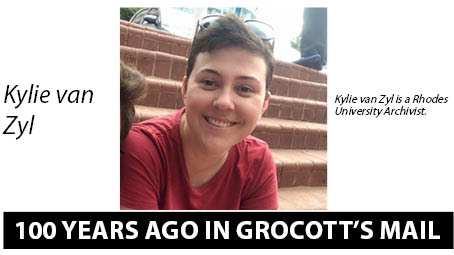110 years ago in Grocott’s Mail… in the archives with Kylie van Zyl
In October and November 1907, Grahamstown was the scene of a sad and bizarre murder trial that occupied hundreds of column inches in both Grocott’s Mail and its rival, the now-defunct Graham’s Town Journal. The murder was never really solved, for all that one man was brought to trial three times, and the mystery continues to this day.
On Tuesday 8 October, an 11-year-old girl named Edith Pinnock was sent by her mother to buy potted meat and a loaf of bread. They lived at the Cradock Toll House, roughly where the turnoff to Rautenbach Road is now, across from the old Grahamstown golf links. The shop, belonging to a Mr Jabez South, was at the corner of Somerset and New Streets. Edith left home at about 11am. It was about five kilometres from her home to the shop and back, and perhaps Edith, who had already done the route once earlier that day, just didn’t feel like rushing. On her way home she greeted a friend on the corner of Somerset and Worcester Streets, and was a little bit later she was seen by two St Andrews Prep boys at the bridge over the railway line on Cradock Road. That was the last anyone saw of her alive.
Edith’s body was found several days later under the old Golf Club clubhouse (not the present building, but the one which burned down in 1915). The Golf Club’s caretaker, a young man named Thomas Kerr, was arrested for her murder and sent to trial in later October. He pleaded innocent, but at first glance the evidence against him looked strong: he had been seen approaching the bridge by the Prep boys while Edith was there, he was her family’s nearest neighbour, his living quarters in the clubhouse smelled like disinfectant, and he had a bad reputation as a drinker and general lowlife. His defence was that he had simply not been there – the Prep boys, who didn’t know him, couldn’t be sure it was him, and he had been at his mother’s house on South Street for some of the day, and had seen his brother-in-law there. He had been in town, selling some tools and drinking at a bar, for the rest of the day; he had returned to the Clubhouse, with a friend, much later and fallen into a drunken sleep. He acknowledged that he knew Edith Pinnock – he had even been helping searchers to dredge the Cradock Dam for her body when the police came to arrest him – but denied strongly, and repeatedly, that he had done anything to her. He explained the disinfectant smell as the result of a self-administered treatment for syphilis.
The sack that Edith’s body had been found in could have been used by Kerr, but also by anyone else who came to the Golf Club in the months it had been lying there. The bread she had had with her was never found, and the tins of potted meat that were found near her body couldn’t be linked to anybody but Jabez South, who wasn’t a suspect, and Edith herself.
The prosecution’s case wasn’t helped by the way that Edith’s body had been discovered. South, owner of the shop Edith had visited before disappearing, claimed that he had identified the killer with the help of a friend of his and young man named Staples, who lived in what is now Sunnyside. Staples and South both claimed to be clairvoyant, and South insisted that he had somehow been guided to the name “Thomas Kerr” by forces unknown. He, Staples and the third man had gone to the Golf Club and looked under the house – and there found Edith.
The judge dismissed this as utter nonsense. Unfortunately for South, he performed badly on the witness stand, insisting that he had not seen Edith turn right up Somerset Street when she left his shop despite previously saying that he had watched her through the shop window. He became muddled and aggressive, and his testimony lost credibility. The Grahamstown detectives didn’t cover themselves in glory either.They had, it seemed, failed to properly investigate or even to properly search for Edith while she was missing. Ultimately, with Kerr able to prove his whereabouts and the prosecution’s case as weak as a wet cornflake, the judge acquitted and released him.
Kerr was re-arrested on a technicality shortly thereafter, as he was trying to leave for King William’s Town (on foot), but a second trial in Grahamstown also failed to secure a conviction. Upon his second arrest, the case was tried in Cape Town – but he was once again acquitted. Kerr always maintained his innocence, and although there are rumours of a deathbed confession of guilt, nobody has ever managed to conclusively prove otherwise.
Nobody knows for sure who killed Edith Pinnock. Kerr might have done it, but he swore he was innocent, and the courts believed him. The police failed to investigate any other possibilities. Indeed, they pretty much failed to investigate Kerr, let alone any other likely suspects. Forensic science at the time was very basic when it came to trace evidence, and there wasn’t much to go on anyway. The courts back then didn’t believe in clairvoyants anymore than they do now. It is just possible – and this writer’s fondest hope – that a document may yet come to light revealing the real fate of Edith Pinnock. But it seems all too likely that the case will remain a mystery.
Queries, suggestions, tips and corrections to nervousflamingo@gmail.com.


